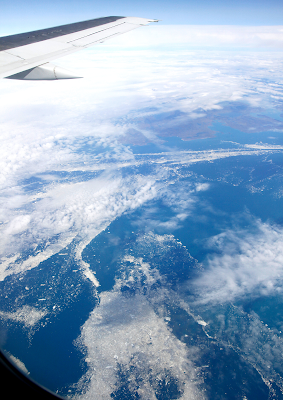Misty shores, moss-covered forests, dappled light, and the smell of salt air—these are my memories of Haida Gwaii, a land where ancient stories are written in stone.Formerly known as the Queen Charlotte Islands, the archipelago of Haida Gwaii lies at the far western edge of Canada, where the Pacific Ocean meets the continental shelf.
These islands—steeped in the rich culture of the Haida Nation—are not only a cultural treasure but a geologic and paleontological wonderland.
Geologically, Haida Gwaii is part of Wrangellia, an exotic tectonostratigraphic terrane that also includes parts of Vancouver Island, western British Columbia, and Alaska. The region's complex geological history spans hundreds of millions of years and includes volcanic arcs, seafloor spreading, and the accretion of entire landmasses.
The Geological Survey of Canada (GSC) has long been fascinated with these remote islands.
Their geologists and paleontologists have led numerous expeditions over the past century, documenting the diverse sedimentary formations and fossiliferous beds.
Much of the foundation for this work was laid by Joseph Frederick Whiteaves, the GSC’s chief paleontologist in Ottawa during the late 19th century.
In 1876, Whiteaves published a pioneering paper on the Jurassic and Cretaceous faunas of Skidegate Inlet. This work firmly established the paleontological significance of the archipelago and cemented Whiteaves’ reputation as a global authority in the field. His paper, "On the Fossils of the Cretaceous Rocks of British Columbia" (GSC Report of Progress for 1876–77), remains a key early reference for West Coast palaeontology.
Later, Whiteaves would go on to describe
Anomalocaris canadensis from the Burgess Shale—an “unlike other shrimp” fossil that would later be recognized as one of the most extraordinary creatures of the Cambrian explosion.
Whiteaves' early work on the fossil faunas of Haida Gwaii, particularly in the Haida Formation, created a foundation for generations of researchers to follow.
One of our most memorable fossil field trips was to the Cretaceous exposures of Lina Island, part of the Haida Formation. We considered it one of our “trips of a lifetime.”
With great sandstone beach exposures and fossil-rich outcrops dating from the Albian to Cenomanian, Lina Island offered both scientific riches and stunning natural beauty.
 |
| Haida Fossil Fauna |
Our expedition was supported and organized by John Fam, Vice Chair of the Vancouver Paleontological Society, and Dan Bowen, Chair of the British Columbia Paleontological Alliance and the Vancouver Island Paleontological Society.
Their dedication to fostering collaborative research and building relationships with local Haida communities was key.
We were warmly welcomed, and field trips to fossil sites were arranged in partnership with community members and cultural stewards.
The Haida Formation yielded beautifully preserved specimens embedded both in bedding planes and in concretions—hard, rounded nodules that often house exceptionally preserved fossils.
Collecting in the mists along the foreshore, our finds included:
- Douvilleiceras spiniferum
- Brewericeras hulenense
- Cleoniceras perezianum
- Fossil cycads, evidence of rich Cretaceous plant life
These fossils offered a rare glimpse into an ancient marine ecosystem that once teemed with life. Douvilleiceras, a spiny ammonite, is particularly striking.
 |
| Douvilleiceras spiniferum, Haida Gwaii |
This genus, first identified by Whiteaves from Haida Gwaii, ranges from the Middle to Late Cretaceous and has been found across Asia, Africa, Europe, and the Americas.
The Haida specimens, from the early to mid-Albian, to my eye are the most beautiful—and beautifully preserved.
Douvilleiceras is one of my favourite ammonites of all time and I was blessed to find several good examples of that species from our expeditions to these fossil-rich outcrops.
All of the fossils I collected from Haida Gwaii have been skillfully prepped and donated to the Haida Gwaii Museum in Skidegate, British Columbia.
It is a privilege to contribute in a small way to the scientific and cultural understanding of these extraordinary islands.
References and Further Reading:
Whiteaves, J.F. (1876). On the Fossils of the Cretaceous Rocks of British Columbia. Geological Survey of Canada, Report of Progress.
Jeletzky, J.A. (1970). Paleontology of the Cretaceous rocks of Haida Gwaii. Geological Survey of Canada, Bulletin 175.
Haggart, J.W. (1991). New Albian (Early Cretaceous) ammonites from Haida Gwaii. Canadian Journal of Earth Sciences, 28(1), 45–56.
Haggart, J.W. & Smith, P.L. (1993). Paleontology and stratigraphy of the Cretaceous Queen Charlotte Group. Geological Survey of Canada Paper 93-1A.
Carter, E.S., Haggart, J.W., & Mustard, P.S. (1988). Early Cretaceous radiolarians from Haida Gwaii and implications for tectonic setting. Micropaleontology, 34(1), 1–14.







%20Fram%20Formation%20of%20Nunavut,%20Canada.%20The%20genus%20contains%20a%20single%20species,%20Q.%20wakei,%20known%20from%20a%20partial%20skele.png)

.jpg)










.png)






.jpg)








